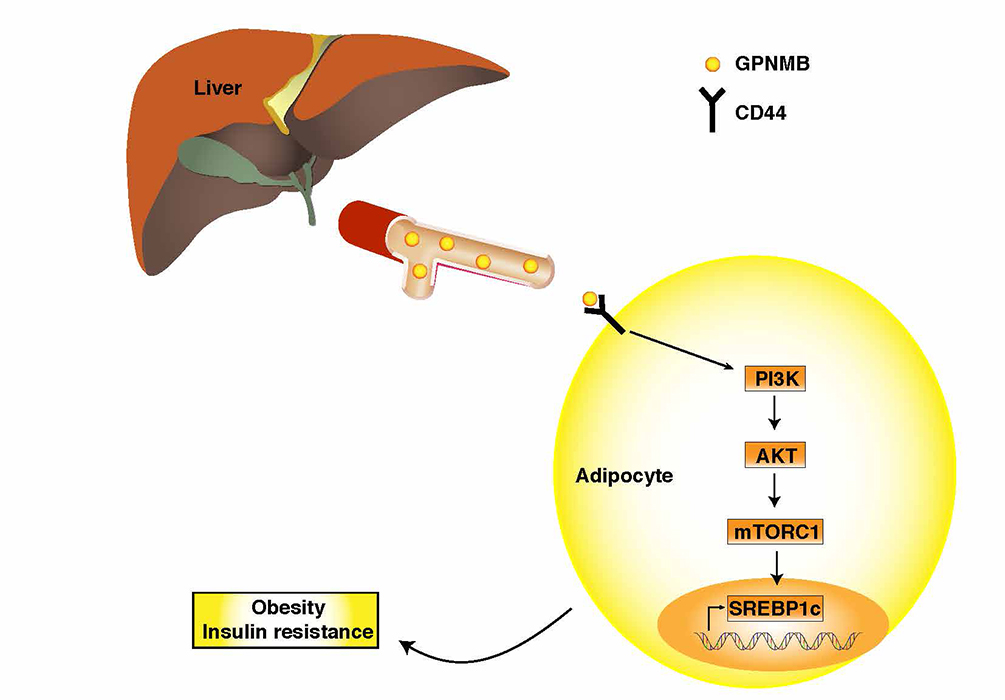A team of scientists led by SLST’s Dr. Qi Wei from and Dr. Song Baoliang from Wuhan University has identified Gpnmb as a liver-secreted factor promoting lipogenesis in white adipose tissue and aggravating obesity and insulin resistance. Using neutralizing antibody, they also demonstrated that reducing circulating Gpnmb brought therapeutic benefit to obesity and diabetes in animal models. This study, published in Nature Metabolism, identified and validated Gpnmb as a therapeutic target for treating obesity and diabetes. Accompanied with a News and Views commentary, the report went online on May 6th, 2019.
Obesity is becoming increasingly prevalent and problematic worldwide. The WHO reported that “in 2016, more than 1.9 billion adults, 18 years or older, were overweight. Of these over 650 million were obese.” Characterized by excessive triglyceride in adipose tissue, obesity is associated with increased risk for type 2 diabetes (T2D), cardiovascular disease, non-alcoholic fatty liver disease, and cancer.
Metabolism in mammals is regulated by complex interplay among different organs. Fatty acid synthesis is increased in white adipose tissue (WAT) when it is inhibited in the liver. However, the exact mechanisms underlying liver-WAT communication remain largely unknown. The authors identified glycoprotein non-metastatic melanoma protein B (Gpnmb) as one liver–WAT cross-talk factor involved in lipogenesis. Inhibition of the hepatic sterol regulatory element-binding protein pathway leads to increased transcription of Gpnmb and promotes processing of the membrane protein to a secreted form. Gpnmb stimulates lipogenesis in WAT and exacerbates diet-induced obesity and insulin resistance. In humans, Gpnmb is closely associated with body mass index and is a strong risk factor for obesity. Gpnmb inhibition by a neutralizing antibody or liver-specific knockdown improves metabolic parameters, including weight gain reduction and increased insulin sensitivity, probably by promoting the beiging of WAT. These results suggest that Gpnmb is a liver-secreted factor regulating lipogenesis in WAT, and that Gpnmb inhibition may provide a therapeutic strategy in obesity and diabetes.
Read more at: https://www.nature.com/articles/s42255-019-0065-4
Dr. Qi Wei joined SLST ShanghaiTech University in March 2018, and her research interests include identifying the biomarkers for epigenetic cancer drug and understanding the epigenetic regulation of metabolism. Prior to ShanghaiTech, she was with Novartis Institutes of Biomedical Research, where she discovered the PRC2 inhibitors (Qi W. et al., Nat. Chem. Biol., 2017) and demonstrated that LSD1 played a key role in brown adipocyte differentiation and brown adipose tissue development (Chen Y. et al. Cell Chem. Biol., 2016). A Post-doc position is currently open in her lab with the focus in epigenetic regulation of lipid metabolism. Interested applicants are encouraged to send an application letter and CV to Dr. Qi directly (qiwei@shanghaitech.edu.cn).

Gpnmb is a newly discovered obese-promoting factor, which is also a target for treating obesity and diabetes. Liver-originated and shed form of Gpnmb protein works on adipocytes to activate SREBP, promoting lipogenesis, impair UCP1-mediated heat production, and therefore aggravate systemic obesity and insulin resistance.

